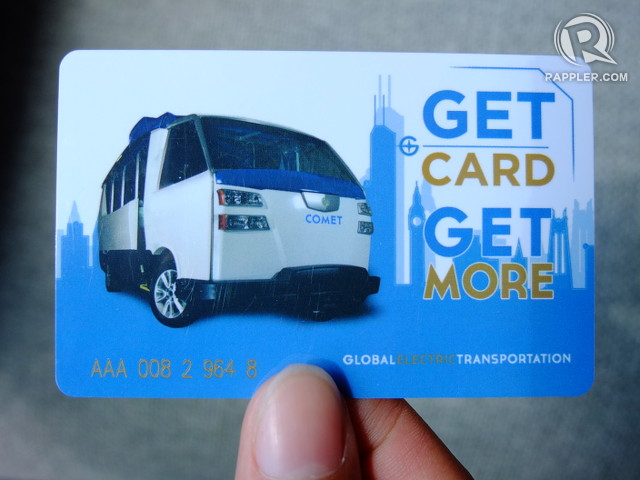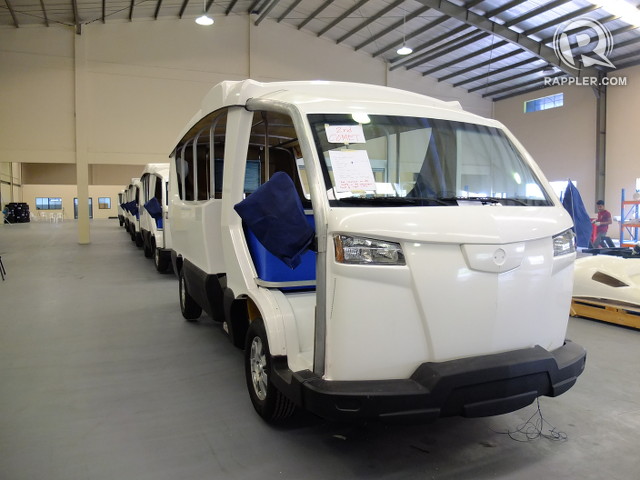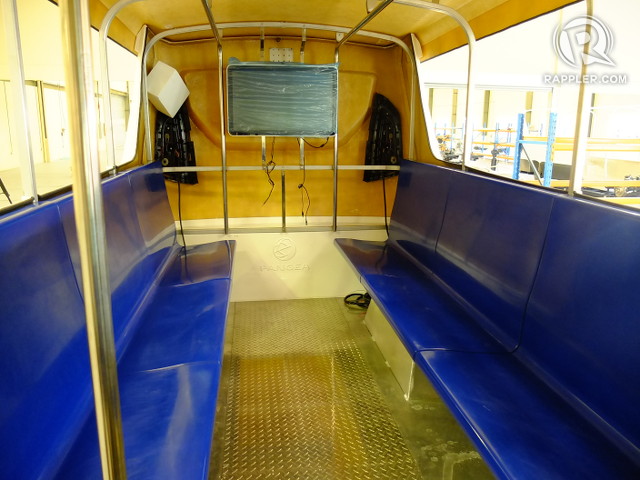SUMMARY
This is AI generated summarization, which may have errors. For context, always refer to the full article.

MANILA, Philippines – The electric-powered jeepneys set to ply Quezon City roads by the end of 2014 have been given their first route: SM North EDSA to the Katipunan LRT 2 station via Luzon Avenue.
The 30 e-jeepneys – officially called GET COMETs – that will be the first to travel this route are in various stages of completion in a factory in Carmona, Cavite.
While Global Electric Transport (GET) media relations manager Ana Santos declined to give a specific date when the route will be activated, she said: “Test drives of the COMETs will start in the next few months. Commuters who ride it can get unlimited rides for free since they are helping us test it.”
Departing from traditional Philippine jeepneys which tend to stop anywhere on the road to let in or let out passengers, GET COMETs will have designated stops.
The southbound route will have 14 stops:
Start: SM North EDSA Terminal
- Road 3
- Congressional Avenue cor Mindanao Avenue
- Northridge Plaza
- Congressional Ave cor Visayas
- Congressional Ave cor Tandang Sora
- UP Professors Subdivision
- Tierra Pura
- Talipapa
- Capitol Hills Drive
- Magsasay Ave/UP GT Toyota Gate
- Quirino Ave/UP Narra Gate
- J Escaler St/Elizabeth Hall Building
- Loyola Heights Brgy Hall/Regis Building
- Ateneo Gate 2 Overpass
End: LRT Katipunan Terminal
Here are the stops for the northbound route:
Start: LRT Katipunan Terminal
- Ateneo Gate 2 Overpass
- Miriam College
- UP Town Center
- Balara Jeepney Station/LWUA
- MWSS (Maynilad Water)
- Capitol Hills Drive
- Talipapa
- Mira Nilla Subdivision
- Tierra Verde
- Congressional Avenue cor Tandang Sora
- Congressional Avenue cor Visayas Avenue
- Circle C/Cherry Fooderama
- Puregold Mindanao Avenue/BJMP
- Road 16
End: SM North EDSA Terminal
This first route was recommended by the Department of Transportation and Communication (DOTC) after looking into factors like traffic congestion and route capacity.
Other considered routes were SM North EDSA-SM Mega Mall and SM North EDSA to Monumento.
Reloadable card, command center
The GET COMETs will also do away with the “barya lang sa umaga (only change in the morning),” pass-along scheme of paying the driver or conductor.
Instead, COMET passengers will purchase a reloadable card which they use to pay in a tap-in, tap-out system.
The fare will be the same as the traditional jeepney fare (P8.50) but a ride through the entire route is P20, said Santos.
The reloadable card itself sells for P20.
The GET COMETs will also be managed by a “Command Center” that monitors where each COMET is, said Jay Meloto, Operations Head of Pangea Philippines, the company that manufactures the COMETs.
Operators at the Command Center not only check on each GPS-connected COMET but are able to observe traffic flows and congestion, allowing them to direct COMETs where they need to go.
“For example, if there are too many COMETs waiting in one station while another station is empty, the Command Center can tell the drivers to go to the empty station,” explained Santos.
The virtual brain of the COMET system also keeps abreast of accidents, flooding and other happenings along the route that can affect the passengers and drivers.
But it’s not only the Command Center that will be in the know. Each COMET will have an LCD television that will flash news bites and advertisements to passengers. It will also provide free WiFi connection.
Future of e-vehicles
The GET COMETs were supposed to be finished in April but the Manila port congestion delayed the delivery of parts from the US, Italy and China, said Santos.
But the next batch of COMETs will have more parts made in the Philippines to ensure quicker and cheaper manufacturing.
COMETs are fully powered by lithium ion batteries (the same batteries in cellular phones), are made of fiberglass, and can seat 21 people.
They will be driven by former jeepney drivers from jeepney driver association Pasang Masda who traded in their old jeeps for COMETs.
While the GET COMETs hope to be the first cashless, managed e-jeepney system in Metro Manila, other electric vehicles can already be found in the mega city. (READ: ‘One million electric vehicles in PH by 2020’)
Makati was the first to have e-jeepneys. In Pasig City, one can catch an electric tricycle or e-trike.
Through a joint project of the Asian Development Bank and Department of Energy, some 3,000 e-trikes will be introduced to other Metro Manila cities and nearby provinces.
The 5-year project aims to put 100,000 e-trikes on Philippine roads by the end of 2017.
Electric vehicles have gained a good reputation in some sectors for their promise of solving air pollution and reducing dependence of the transport system on erratic petroleum prices. – Rappler.com
Add a comment
How does this make you feel?



There are no comments yet. Add your comment to start the conversation.